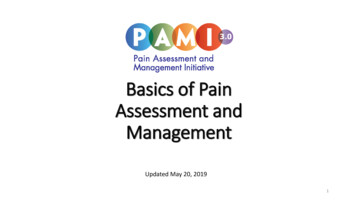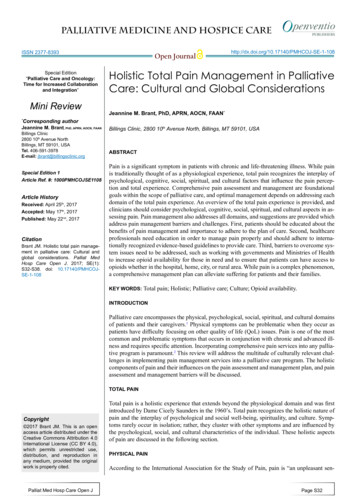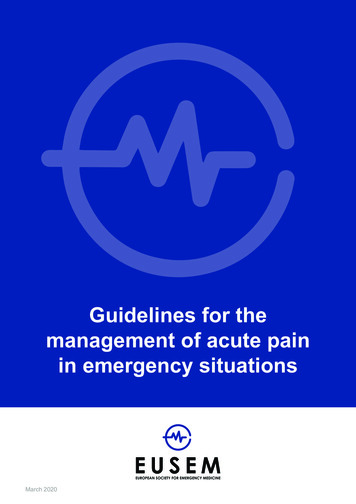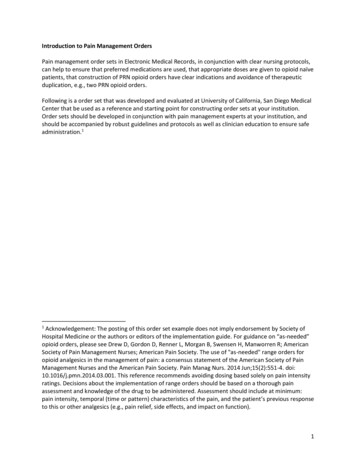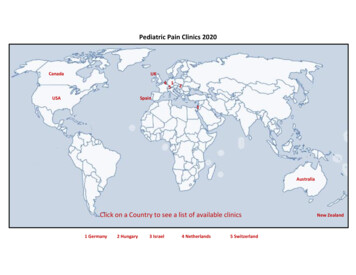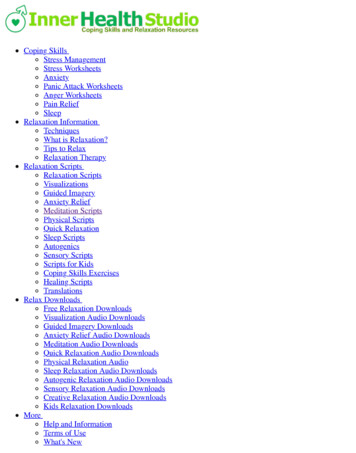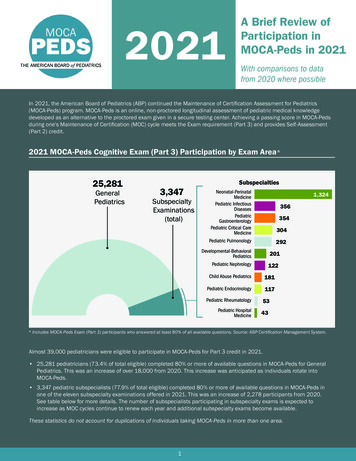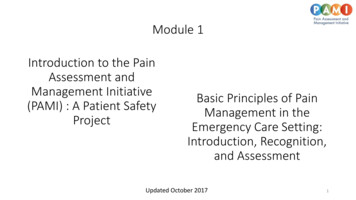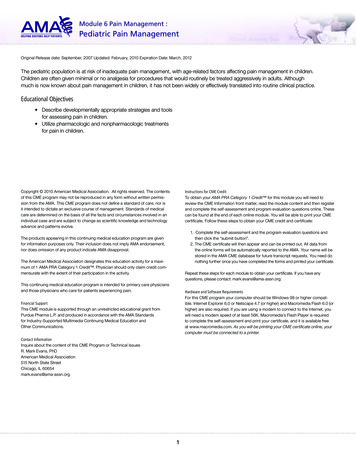
Transcription
Module 6 Pain Management :Pediatric Pain ManagementOriginal Release date: September, 2007 Updated: February, 2010 Expiration Date: March, 2012The pediatric population is at risk of inadequate pain management, with age-related factors affecting pain management in children.Children are often given minimal or no analgesia for procedures that would routinely be treated aggressively in adults. Althoughmuch is now known about pain management in children, it has not been widely or effectively translated into routine clinical practice.Educational Objectives Describe developmentally appropriate strategies and toolsfor assessing pain in children. Utilize pharmacologic and nonpharmacologic treatmentsfor pain in children.Copyright 2010 American Medical Association. All rights reserved. The contentsof this CME program may not be reproduced in any form without written permission from the AMA. This CME program does not define a standard of care, nor isit intended to dictate an exclusive course of management. Standards of medicalcare are determined on the basis of all the facts and circumstances involved in anindividual case and are subject to change as scientific knowledge and technologyadvance and patterns evolve.Instructions for CME CreditTo obtain your AMA PRA Category 1 Credit for this module you will need toreview the CME Information front matter, read the module content and then registerand complete the self-assessment and program evaluation questions online. Thesecan be found at the end of each online module. You will be able to print your CMEcertificate. Follow these steps to obtain your CME credit and certificate:1. Complete the self-assessment and the program evaluation questions andthen click the “submit button”.2. The CME certificate will then appear and can be printed out. All data fromthe online forms will be automatically reported to the AMA. Your name will bestored in the AMA CME database for future transcript requests. You need donothing further once you have completed the forms and printed your certificate.The products appearing in this continuing medical education program are givenfor information purposes only. Their inclusion does not imply AMA endorsement,nor does omission of any product indicate AMA disapproval.The American Medical Association designates this education activity for a maximum of 1 AMA PRA Category 1 Credit . Physician should only claim credit commensurate with the extent of their participation in the activity.Repeat these steps for each module to obtain your certificate. If you have anyquestions, please contact: mark.evans@ama-assn.org.This continuing medical education program is intended for primary care physiciansand those physicians who care for patients experiencing pain.Hardware and Software RequirementsFor this CME program your computer should be Windows 98 or higher compatible. Internet Explorer 6.0 or Netscape 4.7 (or higher) and Macromedia Flash 6.0 (orhigher) are also required. If you are using a modem to connect to the Internet, youwill need a modem speed of at least 56K. Macromedia’s Flash Player is requiredto complete the self-assessment and print your certificate, and it is available freeat www.macromedia.com. As you will be printing your CME certificate online, yourcomputer must be connected to a printer.Financial SupportThis CME module is supported through an unrestricted educational grant fromPurdue Pharma L.P. and produced in accordance with the AMA Standardsfor Industry-Supported Multimedia Continuing Medical Education andOther Communications.Contact InformationInquire about the content of this CME Program or Technical IssuesR. Mark Evans, PhDAmerican Medical Association515 North State StreetChicago, IL 60654mark.evans@ama-assn.org1
Module 6 Pain Management :Pediatric Pain ManagementCME Principal FacultyAmerican Medical AssociationPerry G. Fine, MD, Content ConsultantAssociate Medical DirectorPain Management CenterProfessor of AnesthesiologyUniversity of UtahSalt Lake City, UTAmerican College of Obstetricians and GynecologistsAmerican Academy of Family PhysiciansJonathan S. Berek, MD, Content ReviewerProfessor and Chair, College of Applied AnatomyExecutive Vice Chair, Department of OB/GYNChief, Gynecology ServiceChief, Division of Gynecologic OncologyDavid Geffen School of Medicine at UCLALos Angeles, CACheryl L. Lambing, MD, Content ReviewerAssistant Clinical ProfessorUniversity of California , Los AngelesVentura, CAAmerican Society of AnesthesiologistsPauline Lesage, MD, LLM, Contributing AuthorMedical Director, Jacob Perlow HospiceBeth Israel Medical CenterAssociate Professor, Family MedicineAlbert Einstein School of MedicineNew York, NYPhilipp M. Lippe, MD, Content ReviewerExecutive Medical DirectorAmerican Academy of Pain MedicineClinical Professor of NeurosurgeryStanford UniversityStanford, CAArthur G. Lipman, PharmD, Content ConsultantProfessor, College of Pharmacy & Directorof Clinical PharmacologyPain Management Center, Pain Medicineand Palliative Care Advisory GroupHuntsman Cancer InstituteUniversity of Utah Health Sciences CenterSalt Lake City, UTRussell K. Portenoy, MD, Contributing Author,Planning CommitteeChairman, Department of Pain Medicineand Palliative CareBeth Israel Medical CenterNew York, NYProfessor of Neurology and AnesthesiologyAlbert Einstein College of MedicineBronx, NYAmerican Academy of NeurologyCharles E. Argoff, MD, Content ConsultantCo-Director, Cohn Pain Management CenterAssistant Professor of NeurologyNorth Shore University HospitalManhasset, NYMay L. Chin, MD, Content ReviewerProfessor of AnesthesiologyDirector, Pain Management CenterGeorge Washington University HospitalWashington, DCAmerican Pain SocietyScott M. Fishman, MD, Content ReviewerProfessor and Chief, Division of Pain MedicineDepartment of Anesthesiology and Pain MedicineUniversity of California , DavisSacramento, CAAmerican Academy of Pain MedicineKenneth A. Follett, MD, PhD, Content ReviewerProfessor, NeurosurgeryUniversity of Iowa Hospital & ClinicsIowa City, IAAmerican Academy of PediatricsConstance S. Houck, MD, Contributing AuthorSenior Associate in Anesthesia, Departmentof Anesthesiology, Perioperative and Pain MedicineChildren’s HospitalAssistant Professor, AnesthesiaHarvard Medical SchoolBoston, MAAmerican Academy of Orthopaedic SurgeonsL. Andrew Koman , MD, Content ConsultantVice Chair and Professor, Departmentof Orthopedic SurgeryWake Forest University School of MedicineWinston-Salem, NCAmerican Academy of Physician AssistantsSharon Kulesz, PA-C, Content ReviewerAssistant Director of Professional Affairs, AAPAAlexandria, VA2American Society of Addiction MedicineSeddon R. Savage, MD, MS, Content ConsultantPain Consultant, Manchester VAMCAssociate Professor of AnesthesiologyAdjunct Faculty, Dartmouth Medical SchoolBradford, NHAmerican Psychiatric AssociationJon Strelzer, MD, Content ConsultantProfessor, Department of PsychiatryJohn A. Burns School of MedicineUniversity of Hawaii at ManoaHonolulu, HIAmerican College of Emergency PhysiciansKnox H. Todd, MD, MPH , FACEP, Content ConsultantDirector, Pain and Emergency Medicine InitiativeAdjunct Associate Professor, Rollins Schoolof Public HealthEmory University School of MedicineAtlanta, GAPlanning CommitteeR Barry Dickinson, PhD, CME Program CommitteeAmerican Medical AssociationMark Evans, PhDAmerican Medical AssociationPatti FitzgeraldAmerican Medical AssociationRussell K. Portenoy, MD, Contributing Author,Planning CommitteeChairman, Department of Pain Medicineand Palliative CareBeth Israel Medical CenterNew York, NYProfessor of Neurology and AnesthesiologyAlbert Einstein College of MedicineBronx, NYArt and IllustrationCopyright 2007-2010 Scott BodellBodell Communications, Inc.
Module 6 Pain Management :Pediatric Pain ManagementDisclosure PolicyIt is the policy of the AMA to ensure balance, independence, objectivity, and scientific rigor in all of its activities. This AMA CME program has been independentlyplanned by the AMA and complies with the AMA Division of Healthcare EducationProducts and Standards’ Policies and Procedures for Resolving Conflicts of Interest(COI) for their CME activities, to identify and resolve COI, review faculty and staffdisclosure statements, and determine the level of participation of the planning committee members, and principal faculty. Faculty and planning committee membershave attested that their financial relationships do not affect their abilityto present well-balanced evidence-based content for this activity.Disclosure of Off-Label UsesThe content of this CME publication may contain discussion of off-label uses ofsome of the agents mentioned. Please consult the product prescribing informationfor full disclosure of labeled uses.CME Needs AssessmentPain is one of the most common reasons for patients to seek medical attention and1-3one of the most prevalent medical complaints in the US. According to the 2006National Center for Health Statistics Report, one in 10 Americans overall and threein five of those 65 years or older said that they experienced pain that lasted a year2or more. More than one-quarter of adults said they had experienced low backpain, and 15% of adults experienced migraine or severe headache in the past threemonths. Between the periods 1988-94 and 1999-2002, the percentage of adultswho took a narcotic drug to alleviate pain in the past month rose from 3.2 percentto 4.2 percent.In order to assure the highest quality of certified CME programming, and to complywith the ACCME Standards for Commercial Support, the AMA requires that allfaculty, planning committee and AMA CME Program Committee members discloserelevant financial relationships with any commercial or proprietary entity producinghealth care goods or services relevant to the content being planned or presented.The following disclosures are provided:For the the millions of Americans who experience persistent pain, the impact on2-4function and quality of life can be profound. Pain is associated with high utiliza4tion of health care and the societal costs related to treatment are compounded bythe loss in productivity associated with persistent pain. Lost productive time fromcommon pain conditions among workers costs an estimated 61.2 billion per year5and most of this is related to reduced performance while at work. The total annualcost of poorly controlled persistent pain most likely exceeds 100 billion.CME Advisory BoardDr. Argoff:Consultant: Pricara, Pfizer, Lilly, Forest, Bristol Myers Squibb,King Pharmaceuticals, sanofi-aventis;Grant support: Endo;Speaker’s Bureau: Endo, Pricara, Pfizer, Lilly, Forest, KingPharmaceuticalsDr. Berek:Nothing relevant to discloseDr. Chin:Nothing relevant to discloseDr. Ferrell:Nothing relevant to discloseDr. Fine:Advisory Board: Endo, Cephalon, Lilly, Alpharma, Wyeth& GlaxoSmithKlineDr. Fishman:Nothing relevant to discloseDr. Follett:Nothing relevant to discloseDr. Houck:Nothing relevant to discloseDr. Koman:Consultant, Wright Medical; Medical Director/Board member,DT Scimed, KeranneticsDr. Kulesz:Nothing relevant to discloseDr. Lambing:Nothing relevant to discloseDr. Lesage:Nothing relevant to discloseMr. Lipman:Consultant: Pfizer, Progenics, Johnson & Johnson, Biovail, NiCox;Speaker’s Bureau: Johnson & Johnson, Forest/CypressDr. Lippe:Nothing relevant to discloseDr. Portenoy:Consultant: Alpharma, Ameritox,Cephalon, GW Pharma, GrupoFerrer, Insys Therapeutics, King Pharmaceuticals, Neuromed,Purdue Pharma, Shire Pharmaceuticals, Titan, TransceptPharmaceuticals, WEX Pharmaceuticals, Wyeth, XenonGrants: Archimedes Pharmaceuticals, Cephalon, Endo Pharmaceuticals, Fralex, GW Pharmaceuticals, King Pharmaceuticals,Pfizer, Inc., Purdue Pharma, United BioSource Corp., WyethDr. Savage:Advisory Board: Ameritox, Registrat, MedaDr. Todd:Consultant: Purdue Pharma; Research Grant, BaxterAMA Editorial StaffDr. Evans:Dr. Dickinson:Ms. Fitzgerald:Dr. Portenoy:Physicians and other healthcare professionals need current, state-of-the-art education to assist them in developing the skills required to evaluate and manage painin children. This CME program reviews important considerations in pain management in children. Strategies for assessing pain, specific pain assessment tools, andpharmacologic and nonpharmacologic management options specific to childrenare also addressed.1. Watkins EA, Wollan PC, Melton LJ 3rd, Yawn BP. A population in pain: report from theOlmsted County health study. Pain Med. 2008;9(2):166-74.Nothing revelant to discloseNothing relevant to discloseNothing revelant to discloseConsultant: Alpharma, Ameritox,Cephalon, GW Pharma, GrupoFerrer, Insys Therapeutics, King Pharmaceuticals, Neuromed,Purdue Pharma, Shire Pharmaceuticals, Titan, TransceptPharmaceuticals, WEX Pharmaceuticals, Wyeth, XenonGrants: Archimedes Pharmaceuticals, Cephalon, Endo Pharmaceuticals, Fralex, GW Pharmaceuticals, King Pharmaceuticals,Pfizer, Inc., Purdue Pharma, United BioSource Corp., Wyeth2. http://www.cdc.gov/nchs/hus.htm3. Blay SL, Andreoli SB, Gastal FL. Chronic painful physical conditions, disturbed sleepand psychiatric morbidity: results from an elderly survey. Ann Clin Psychiatry. 2007 JulSep;19(3):169-74.4. Von Korff M, Lin EH, Fenton JJ, Saunders K. Frequency and priority of pain patients’ healthcare use. Clin J Pain. 2007 Jun;23(5):400-8.5. Stewart, WF, Ricci, JA, Chee, E, Morganstein D, & Lipton R. (2003). Lost productivetime and cost due to common pain conditions in the US workforce. JAMA. 2003;290(18);2443-2454.3
Module 6 Pain Management :Pediatric Pain ManagementIntroduction Lack of knowledge regarding newer modalities and properdosing strategies for the use of analgesics in children. Fears of respiratory depression or other adverse effectsof analgesic medications. The belief that preventing pain in children takes toomuch time and effort.It is now well accepted by neuroscientists and pain specialiststhat the nervous system is sufficiently developed to processnociception before birth, and consequently, children must be1assumed to experience pain from birth onward. Indeed, due toa more robust inflammatory response and the lack of a centralinhibitory influence, infants and young children actually may experience a greater neural response, i.e., more pain sensation andpain-related distress, following a noxious stimulus than do adults.The impact of painful experience on the young nervous systemis so significant that long-term effects can occur, including a2lowered pain tolerance for months after a pain-producing event.Given the certainty that neonates and preverbal children3,4experience pain, the long history of undertreatment cannotbe justified by the lack of easy communication with thesepatients, and certainly not with older children and adolescents.The multifactorial sources of undertreatment of pediatricpain should be understood and provide the basis for professional and parental education, and system changes, that arenecessary to yield best practices in pediatric pain control.Pain Assessment in Infants and ChildrenBecause children have a limited range of experience and may beunable to use words that adequately express their discomfort, determining just how much pain a child is experiencing can be difficult. Cognitive, behavioral, emotional, and psychosocial factors(e.g., family learning, culture), and other factors (e.g., gender)play a role in a child’s pain experiences, with children andadolescents responding to noxious experiences differently atdifferent developmental stages. Observational pain scales havebeen validated for neonates and infants to allow pain assessment in those unable to verbalize their pain. These scales,though essential, also respond to distress from causes otherthan pain, such as hunger, fear or anxiety (e.g., from parentalseparation). Simple self-report scales using facial expressionsor small objects to describe pieces of hurt (i.e., Poker ChipTool) have been devised to allow preschool and school agechildren to more accurately describe the intensity of their pain.Misconceptions That Can Lead to Undertreatment of Pain in ChildrenThe American Academy of Pediatrics and the AmericanPain Society have issued a joint statement recommending that pain be recognized and treated more aggressively in children. They point to several misconceptions5that can lead to undertreatment of pain in children:Observational Pain Scales for Neonates and InfantsWith the widespread use of screening blood tests in the newbornand the large number of neonatal circumcisions performed inhospitals throughout the U.S., researchers have been developingassessment tools and studying the effects of pain in newborns The myth that infants and children do not feelpain, or suffer less from it than adults. Lack of routine pain assessment in children.FLACC Behavioral Pain AssessmentCategoriesScoring012FaceNo particular expression or smileOccasional grimace or frown,withdrawn, disinterestedFrequent to constant quiveringchin, clenched jawLegsNormal position or relaxedUneasy, restless, tenseKicking, or legs drawn upActivityLying quietly, normal position,moves easilySquirming, shifting backand forth, tenseArched, rigid or jerkingCryNo cry, (awake or asleep)Moans or whimpers;occasional complaintCrying steadily, screams orsobs, frequent complaintsConsolabilityContent, relaxedReassured by occasionaltouching hugging or beingtalked to, distractableDifficulty to console or comfortEach of the five categories is scored from 0-2, resulting in a total score between 0 and 10.The FLACC scale was developed by Sandra Merkel, MS, RN, Terri Voepel-Lewis, MS, RN, and ShobhaMalviya, MD, at C. S. Mott Children’s Hospital, University of Michigan Health System, Ann Arbor, MI.Copyright 2002, The Regents of the University of Michigan. Reproduced with permission.4
Module 6 Pain Management :Pediatric Pain Management7for a number of years. These pain assessment scales have beenvalidated in studies of preterm and term neonates and have aidedin the development of similar observational scales for toddlersand cognitively impaired children. Most combine easily obtainedphysiologic parameters such as heart rate and oxygen saturationwith facial expressions such as brow bulge, eye squeeze, andnasolabial furrow and body movements to determine the degreeof discomfort. The most commonly used scales in newborns arethe Premature Infant Pain Profile (PIPP) and the CRIES Postopera6-8tive Pain Scales. The FLACC (Face, Legs, Activity, Cry andConsolability) Scale is a behavioral scale that has been validatedfor assessment of postoperative pain in children between the9ages of 2 months and 7 years. After observing a child for oneto five minutes, a pain score is obtained by reviewing thedescriptions of behavior and selecting the number thatmost closely matches the observed behavior.Poker Chip Tool Instruction Sheet Say to the child: “I want to talk with you aboutthe hurt you may be having right now.” Align the chips horizontally in front of the child on thebedside table, a clipboard, or other firm surface. Tell the child, “These are pieces of hurt.” Beginningat the chip nearest the child’s left side and endingat the one nearest the right side, point to the chipsand say, “This (first chip) is a little bit of hurt and this(fourth chip) is the most hurt you could ever have.” For a young child or for any child who may notfully comprehend the instructions, clarify by saying,“That means this (one) is just a little hurt, this (two)is a little more hurt, this (three) is more yet, and this(four) is the most hurt you could ever have.” Do not give children an option for zero hurt. Research withthe Poker Chip Tool has verified that children without painwill so indicate by responses such as, “I don’t have any.” Ask the child, “How many pieces of hurt do you haveright now?” After initial use of the Poker Chip Tool, some childreninternalize the concept “pieces of hurt.” If a child givesa response such as “I have one right now.” before youask or before you lay out the poker chips, proceed withasking how many pieces of hurt the child has now. Record the number of chips on a pain flow sheet. Clarify the child’s answer by words such as, “Oh,you have a little hurt? Tell me about the hurt.”Self-Report Scales for ChildrenStarting at about 18 months of age, children have acquired wordsfor pain, and 3- or 4-year-old children may be able to report pain,indicate its location, and describe its characteristics. If self-reportis possible, it is the preferred strategy for information-gatheringabout pain. Progress has been made in creating and validatingself-report scales and in understanding the developmental andsocioenvironmental influences on pain report, but research in this10area is needed. Self-report pain scales developed for youngchildren include the Poker Chip Scale, Wong-Baker Faces Scale11-13and the Oucher Scale.The Oucher Scale (www.oucher.org)which is available in different ethnic versions, permits children torate their pain intensity by matching it to photographs of otherchildren’s faces depicting increasing levels of pain. The PokerChip Scale asks children to quantify their pain in “pieces of hurt,”with more poker chips representing more pain. Body outlinesallow young children to point to the location of their pain. Asschool age children learn the proportionality of numbers andcolors, they can generally use the same scales as adults (i.e.,Visual Analog Scale, Numeric Rating Scale) without difficulty.Source: Hester NO, Foster R, Kristensen K. Measurement of pain in children:generalizability and validity of the Pain Ladder and the Poker Chip Tool.In: Tyler DC, Krane EJ, eds. Pediatric pain. Vol. 51. Advances in PainResearch and Therapy. New York: Raven Press, Ltd.; 1990. p. 79-84.Interpreting pain scales can be difficult in young children sincetheir ratings are based on prior experiences of pain. Thus,when young children use the upper end of a scale to rate theirpain, they are indicating its severity relative to their prior pain14experience. For young children, an injury or procedure mightbe the strongest pain they have experienced whereas olderchildren and adults may rate the same injury as less painful,because they have experienced a more diverse array of pain.Several questionnaires have been developed for children withchronic or persistent pain. These include, among others, theVarni-Thompson Pediatric Pain Questionnaire, and the Children’s15,16Comprehensive Pain Questionnaire.5
Module 6 Pain Management :Pediatric Pain ManagementManagement of Acute Pain in Childrenhepatic enzyme systems, including cytochrome P450subtypes, and the mixed-function oxidases, mature at18varying rates over the first 1 to 6 months of life.Acute pain is far more common than chronic pain in children.Pain from injury or illness typically is transitory; most can beeasily managed by the patient and caretakers. Iatrogenicacute pain also is common and extends from the increasingnumber of needle stick procedures (immunizations, screening blood tests) that are performed as a part of preventivemedicine strategies to acute severe pain related to surgery orother procedures done to address a serious medical problem.Unrelieved pain can lead to considerable anxiety and distressand, in some instances, can have long-term physiologicaland behavioral consequences. Though it is impossible toprevent all sources of pain, information is now available to aidpractitioners in providing safe and effective analgesic modalities for both prevention and treatment of childhood pain. Glomerular filtration rates are diminished in the firstweek of life, especially in premature infants, butgenerally are sufficiently mature to clear medica19tions and metabolites by 2 weeks of age. Newborns have a higher percentage of bodyweight as water and less as fat compared witholder patients. Water soluble drugs, therefore,often have larger volumes of distribution. Newborns have reduced plasma concentrations ofboth albumin and alpha-1 acid glycoprotein thanolder children and adults. For some drugs, this maylead to higher concentrations of unbound drug (active),and thereby greater drug effect or drug toxicity.Nonpharmacologic Pain ManagementNonpharmacologic approaches for the treatment of pain inchildren include psychological strategies, education and parentalsupport. For children undergoing repeated painful procedures,cognitive-behavioral therapy interventions, which decrease17anxiety and distress, can be quite effective. The aim of suchtherapies is to provide responses that may help children mastera distressing situation, ideally in a manner consistent with theirbasic coping strategies. Most of these techniques take timeto learn and master, so simple distraction techniques thatdivert attention away from painful stimuli, or positive incentivetechniques which provide a small reward (e.g., stickers or prizes)for attempts at mastery of their responses, can be effective forchildren undergoing occasional procedures. These techniquesare designed to decrease anxiety, but are not adequate asthe sole means of pain relief for most painful procedures. Newborns, and especially premature infants, havediminished ventilatory responses to hypoxemia20,21and hypercarbia.These ventilatory responsescan be further impaired by CNS depressant drugssuch as opioids and benzodiazepines.AcetaminophenDue to its excellent safety profile and lack of significant sideeffects, acetaminophen is the most commonly used analgesicagent in pediatric practice. It is a mainstay for mild to moderatepain, and is often combined with opioid analgesics for patientswith more severe pain (i.e., acetaminophen with codeine).Toxicity can result when the toxic metabolite of acetaminophen,acetyl-p-benzoquinone-imine (NAPQI), is produced in such highquantities that there is not enough glutathione peroxidase (GSH)to bind to it. Infants and children produce high levels of GSH asa part of hepatic growth and this may provide some protectionagainst the hepatotoxicity produced by overdose. This was sug22gested in a rodent study that compared weanling to adult rats.Special Considerations in Treating Infants and ChildrenWhen treating pain in infants it is important to understand thatalthough most of the major organ systems are anatomically welldeveloped at birth, their functional maturity is often delayed. Inthe first months of life in both preterm and full-term newborns,these systems rapidly mature, most approaching a functionallevel similar to adults before 3 months of age. General principlesof newborn physiology and its effects on the pharmacology ofopioids and local anesthetics are described in the following text:Acetaminophen is available orally in several tablet and liquidformulations. Oral dosing of 10 to 15 mg/kg is commonlyrecommended, though single oral doses of 20 mg/kg appearquite safe in children. Neonates have a slower elimination half-lifeso the drug must be given less frequently. Daily maximum oraldosing is recommended not to exceed 90 mg/kg for children,60 mg/kg for term neonates 10 days of age, and 45 mg/23kg for premature infants 34 weeks gestational age. Most analgesics (including opioids and local anesthetics)are conjugated in the liver. Newborns, and especiallypremature infants have delayed maturation of the enzymesystems involved in drug conjugation, including sulfation, glucuronidation, and oxidation. Several of these6
Module 6 Pain Management :Pediatric Pain ManagementRectal preparations of acetaminophen are available for infantsand toddlers who are unable or unwilling to take this medicationorally. A series of studies has confirmed that rectal absorptionis slow, somewhat variable, and comparatively inefficient.Single rectal doses of 30 to 45 mg/kg produced plasmaconcentrations that were generally in the effective range, and24,25never in a range associated with hepatotoxicity.Followingthese large rectal doses, there is a comparatively slow declinein plasma concentrations. Based on a 24-hour kinetic study,it was recommended that initial doses of 35 to 40 mg/kg befollowed by subsequent doses of 20 mg/kg, with the dosing25interval extended to at least 6 hours. If a large rectal dose isto be followed by oral dosing, it is also recommended that afirst oral dose be given no sooner than 6 hours after the initialdose. Dosage guidelines for acetaminophen and the mostcommonly used NSAIDs in children can be found in the table.Ibuprofen is frequently chosen for mild to moderate pain, becauseit is available in a liquid form allowing for easy administrationto younger children. Since it became available as an over-thecounter medication for fever reduction as well as pain relief, thereis a large amount of clinical experience in infants and childrenwith this drug. A review of short-term ibuprofen use in a largecohort of children revealed no increase in clinically significant28renal or GI side effects compared to acetaminophen.Ketorolac is the only parenteral NSAID currently available in theU.S. It has been used both as an adjuvant to opioid analgesia,and as a single agent for the treatment of postoperative painin children and adolescents. One study demonstrated thatthe administration of a single dose of 0.8 mg/kg of ketorolaccould reduce the need for self-administered opioid analgesia29by approximately 30% in the first 12 hours after surgery. Thisled to a significant reduction in urinary retention comparedto opioid analgesia alone. Dosage recommendations havebeen reduced in the last few years to 0.25 to 0.5 mg/kg every6 hours with no requirement for a loading dose. A review ofthe short-term use (48 hours) of intravenous ketorolac in over301,700 children demonstrated a low rate of complications.Nonsteroidal Anti-inflammatory DrugsExcept in the newborn period, when the half-life after administration is significantly longer, the pharmacodynamics and pharmacokinetics of NSAIDs in children are not much different than in26adults. Although the potential for GI, renal
Module 6 Pain Management : Pediatric Pain Management Disclosure Policy It is the policy of the AMA to ensure balance, independence, objectivity, and sci-entific rigor in all of its activities. This AMA CME program has been independently planned by the AMA and complies with the AMA Division of Healthcare Education


